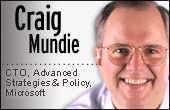Microsoft's 'Godfather' sticks to his guns

 |
newsmaker Craig Mundie, chief technical officer of Microsoft's strategic alliance and policy division, has spent a good part of his 14-year career at Microsoft dreaming up cool technology.
Besides working closely with Microsoft Chairman Bill Gates to develop technical, business and policy strategies for the company on a global scale, Mundie is also hands-on when it comes to thinking up new ideas for Microsoft's non-PC computing business.
In part 2 of a recent interview with ZDNet Asia, Mundie talks about the different ways in which Microsoft has innovated beyond the desktop PC and applied its technologies in new exciting ways.
Fourteen years at Microsoft is a long time. How did it all start?
I've only had three jobs [in my life]. In my younger days, I joined Data General, because they acquired a start-up company that I was in when I was still in university. I worked as a programmer and became a senior manager for R&D. In 1982, I left [and together with another man], we decided to start up another company. We ended up designing a supercomputer and built a mini-supercomputer company in the Boston area, and I [ran the business] for about 11 years. In 1992, I joined Microsoft as the general manager of the then non-existent division which focused on software for non-PC products.
| I was the Godfather at Microsoft of all the non-PC computing activities. |
Thirteen years ago, I went to Microsoft to lay the foundations for a world--which Bill Gates, Nathan Myhrvold, (who was the CTO of Microsoft at that time), and I all shared a dream--in which microprocessors and software would find their way into almost everything in our lives. And in 1992, that was a very avant-garde thought. But today, people take that for granted. [For example], you've got a microprocessor in that little tape recorder. All of our phones and cars have dozens of microprocessors, and so there is a huge and growing demand for intelligent systems and software in virtually every aspect of our work, home and entertainment lives.
Describe your involvement in these "avant-garde" projects.
I was the 'Godfather' at Microsoft of all the non-PC computing activities. In my first six years there, I started all of our initial activities in interactive television, I did the first game machine, I did the first smart watch, I did the first automotive product, I started the initial work in cell phones, and so many of the things that society is accepting of today. It was a fun and great experience. [These projects] also show how long the lead time is between when you start doing the basic research and development and when the global society at large is prepared to embrace them in a big way.
This is our 13th year developing advanced interactive television technologies, and it's really the first year that any of it is going into broad-scale, commercial deployment. One of the things that distinguishes Microsoft is not only our willingness to invest in pure research but also to invest in these new categories that have very, very long lead times to commercialization. But today, Microsoft is the only technology company in the world that has a competitive offer in every category from watches to cars, to cell phones, to televisions, to game machines, to personal computers and servers. We have competition in every category, but no other company really invests to be able to try to provide an integrated offering across all of these areas. That is something that I think will show some benefit over time.
What else are you betting on that could change our lives in the next few years?
Perhaps the thing that has been layered on top of that in the last few years is the focus on the opportunity to add a Web-service component to almost every one of our products. In the past, Microsoft was a company that had both platform offerings like Windows and applications like Office, but they were both confined to the personal computer.
What's happened now is we have spent more than a decade providing that same level of platform and solution capability across a much broader array of device categories, as well as in a sort of raw form for people who want to embed this into their own products-- whether it's a CAT (Computerized Axial Tomography) scan in the hospital or a braking system in a vehicle. We have technology to enable a lot of that. We also started more than a decade ago to create MSN. The evolution of that, together with Hotmail, and more recently the Live services for Windows and Office, shows we believe that there is a service-oriented component that can be offered in conjunction with these other software.
Similarly, we continue to see very rapid acceleration in the use of microprocessors and more advanced software in many devices. I can remember many years ago, when we were developing Windows CE and Pocket PCs, people would say to us, hey, we've got this little Palm Pilot and that's all we ever need. Today, that looks pretty antiquated. People are now saying: We like these smart phones and Pocket PC phones with integrated cameras, WiFi, Bluetooth, IP networking, Web forms and all these other things all on my pocket computer. I'd like to believe that we were more accurate in forecasting how the world would move towards expecting this level of technology sophistication.
We also see the evolution beyond typing and point-and-click kind of interfaces. Lately, we've been doing a lot of work in machine vision, and so we would hope that in the years ahead we'd be able to extend the modalities by which people interface with these computer systems, and therefore make the interactions with computer systems more like [how] you would interact with another individual.
You mentioned that the lead time in bringing an idea out to the market is long. What are the challenges in predicting what people want and having the conviction to follow through the ideas?
Getting acceptance is in many ways a process of success and refinement. Even if you have the right vision of what's going to happen, it's difficult to get all the pieces right the first time. So for example in 1992, we were more focused at the time on ATM (Asynchronous Transfer Mode) networks rather than traditional IP packet-based networks, because at that time, the network operators were investing more heavily there. As IP networks matured and [due to the rise] in the Internet phenomenon, there was a gradual shift.
| I'd like to believe that we were more accurate in forecasting how the world moved to expect [a high level] of sophistication [in handheld devices]. |
We were able then to migrate our early work from TV-based on ATM-type switch telephone networks to an IP packet-based system. Today, Microsoft is the world leader in IP-based TV systems. You not only have to have the right idea, but [you also need to have] the ability to stick with it, which is a cultural issue, a financial issue, and a willpower issue. Microsoft has been fortunate to have command of all three of those things.
How does Microsoft foster the spirit innovation within the organization?
I can look at this along three different horizons and organizational approaches. Firstly, I think it's important to have a pipeline of partially-directed research. In other words, [having] people who are trying to develop core technologies but not operating under the pressure of an immediate product deliverable. So when they begin, they do not know what outcome they would expect to get other than we hope that they would produce some useful core technology. We've got company research activities in around 60 areas that may be important in our broad product lines in the future, and we make that as a baseline investment.
The second thing that we do is to support incubations. Some of those are sponsored by the CTO office and some of those are done by teams focused on incubations within individual business groups. I define incubation as an attempt to nurture something that is not a pure research activity any longer, but where it's not exactly clear either what the 'productization' strategy would be, or how long it would take to be achieved. And so, you require people who are a bit more entrepreneurial by nature, and who is, to some extent, able to take some personal time and career investment risk to seek a novel new product or new market strategy.
The third area is essentially the normal evolution of the products. By listening to the market and getting feedback from customers, and being willing to adapt, you get another form of innovation. For example, when people look at the new version of Office, which is in beta test right now, there is quite a radical change in the basic model of the graphical user interface for the Office system. So on one hand you could say hey, it's still Word, Excel and PowerPoint…What's the big deal? On the other hand, if the change in this interface really makes it easier to introduce more sophisticated capabilities, for example, to embed real-time communications and collaboration in what was historically a personal Office suite, then that's a breakthrough in its own right.
When you realize that there are hundreds and millions of people who spend many hours a day working with these tools, and if you could come up with a way of improving their productivity--even by what appears to be small percentages amplified by the number of people doing it everyday--that actually has a material effect.